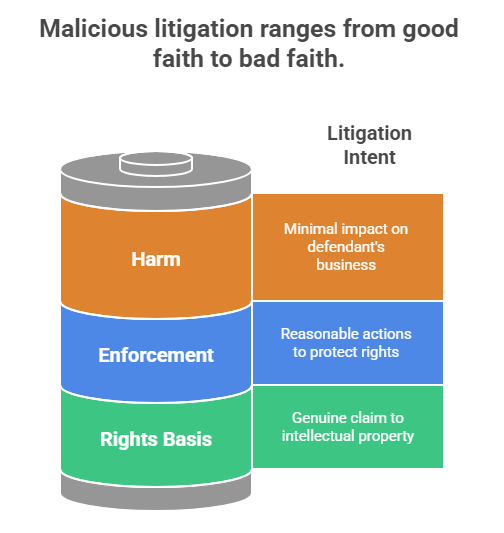Foreign businesses operating in China increasingly face a concerning threat: malicious intellectual property litigation. Unscrupulous entities may weaponize trademarks, patents, or copyrights – often obtained dubiously – to launch frivolous lawsuits. Their goals? Extort settlements, disrupt operations, or eliminate competition. Understanding how Chinese courts define and penalize “abuse of rights” is critical for protection.

Defining Malicious IP Litigation Under Chinese Law
Chinese law doesn’t explicitly label litigation “malicious,” but courts assess bad faith through actions and intent. Key indicators include:
- Lack of Legitimate Rights Basis:
- Trademarks: Registrations obtained via fraud, squatting, or violating good faith (e.g., copying well-known foreign brands not yet registered in China). (Trademark Law, Art. 4, 7, 32, 44).
- Patents: Asserting patents known to be invalid (lacking novelty/inventiveness), or “junk patents” acquired solely for litigation. (Patent Law, Art. 22, 45-47).
- Copyrights: Claiming rights over unoriginal works, works in the public domain, or works created by others.
- Evident Bad Faith in Enforcement:
- Extortion Tactics: Demanding grossly disproportionate settlements far exceeding potential damages or licensing value.
- Serial Litigation: Repeatedly suing multiple parties over the same dubious right without genuine intent to protect a business interest.
- Strategic Timing: Launching suits coinciding with competitor funding rounds, major contracts, or IPOs to inflict maximum damage.
- Concealing Key Facts: Hiding prior art (for patents), prior use rights (for trademarks/copyrights), or evidence undermining their own claim validity.
- Objective Harm:
The defendant must demonstrate actual harm: operational disruption, reputational damage, significant legal costs, or lost business opportunities.
How Chinese Courts Determine Abuse
Courts examine the totality of circumstances. Recent judicial interpretations and cases emphasize:
- Subjective Intent: Did the plaintiff know or should they have known their right was invalid or unenforceable? Did they acquire the right primarily for litigation? (Referencing principles in Civil Code Art. 132: “No abuse of rights”).
- Objective Acts: Were the litigation demands and methods reasonable? Were procedural rights (e.g., evidence preservation, injunctions) misused aggressively?
- Proportionality: Is the harm caused by the lawsuit grossly disproportionate to any legitimate interest the plaintiff might possess?
- Violation of Good Faith: Foundational principle across Chinese IP laws (Trademark Law Art. 7, Patent Law Art. 20, Anti-Unfair Competition Law).
Legal Grounds for Counterattack & Remedies
Victims of malicious suits have powerful countermeasures:
- Invalidate the Underlying IP Right:
- File invalidation petitions with the CNIPA (China National Intellectual Property Administration) against the asserted trademark or patent. Success immediately nullifies the lawsuit’s basis. This is often the most decisive move.
- Argue copyright non-infringement based on lack of originality, fair use, or independent creation.
- File a Counterclaim for Abuse of Rights (or Malicious Litigation):
- Legal Basis: Civil Code Art. 1165 (Tort Liability), Art. 132 (Abuse of Rights); Judicial Interpretations on IP Infringement Damages; Anti-Unfair Competition Law (if harming competition).
- Required Proof: Evidence proving the plaintiff’s bad faith (e.g., prior warnings ignored, evidence of squatting, history of similar suits) AND the damages suffered (legal fees, operational losses, reputational harm).
- Seek Declaratory Judgment of Non-Infringement:
Proactively seek a court declaration that your activities do not infringe, especially if threatened. - Apply for Litigation Preservation Measures (Carefully):
If the plaintiff seeks an injunction freezing assets, demand a high counter-guarantee. If granted an injunction against you based on bad faith, seek compensation for wrongful enforcement.
Proving Your Case: The Critical Role of Evidence
Success hinges on robust evidence demonstrating the plaintiff’s bad faith and your losses:
- Invalidation Decisions: CNIPA rulings cancelling the plaintiff’s trademark/patent are gold-standard evidence of lack of rights basis.
- Prior Art/Use Evidence: Documents proving the plaintiff’s IP lacked novelty or that you (or others) used the mark/technology before their filing date.
- Communication Records: Demands for excessive settlements, threats, refusal to negotiate reasonably.
- Plaintiff’s Litigation History: Proof of serial, pattern-based lawsuits with the same IP.
- Market Analysis: Demonstrating the plaintiff has no real commercial use for the IP, acquired it solely for litigation.
- Cost Documentation: Detailed records of legal fees, operational disruption costs, lost profits.
Strategic Prevention: Due Diligence is Your First Defense
The best countermeasure is preventing malicious suits before they start:
- Comprehensive IP Clearance Searches: Before market entry or product launch, conduct exhaustive searches for conflicting:
- Trademarks: Identical and similar marks across relevant classes.
- Patents: Existing patents and utility models covering your technology.
- Copyrights: Especially for software, designs, and content.
- Verify authenticity and ownership history – look for signs of squatting. Our specialized Intellectual Property Search Reports provide this critical intelligence.
- Proactive IP Registration: Secure your core trademarks, patents, and designs in China early. First-to-file rules dominate.
- Document Everything: Maintain clear records of independent creation, prior use, and legitimate business activities.
- Monitor IP Gazettes: Watch for suspicious registrations mimicking your brands or tech. File oppositions/invalidations promptly.
Conclusion: Navigating the System Requires Diligence and Proof
China’s legal framework provides legitimate avenues to combat malicious IP litigation, but success demands a proactive, evidence-based strategy. Courts are increasingly intolerant of bad-faith enforcement, especially under the reinforced principle of good faith. The cornerstone of defense remains rigorous pre-emptive due diligence – understanding the true landscape of existing rights that could be weaponized against you. When faced with a suspicious suit, swift action to invalidate the underlying IP and counterclaim for abuse, backed by irrefutable evidence of bad faith and damages, offers the strongest path to justice and deterrence.
